In the field of electronic devices, roll-to-roll processing, also known as web processing, reel-to-reel processing or R2R, is the process of creating electronic devices on a roll of flexible plastic, metal foil, or flexible glass. In other fields predating this use, it can refer to any process of applying coating, printing, or performing other processes starting with a roll of a flexible material and re-reeling after the process to create an output roll. These processes, and others such as sheeting, can be grouped together under the general term converting. When the rolls of material have been coated, laminated or printed they can be subsequently slit to their finished size on a slitter rewinder.

Diamond-like carbon (DLC) is a class of amorphous carbon material that displays some of the typical properties of diamond. DLC is usually applied as coatings to other materials that could benefit from such properties.
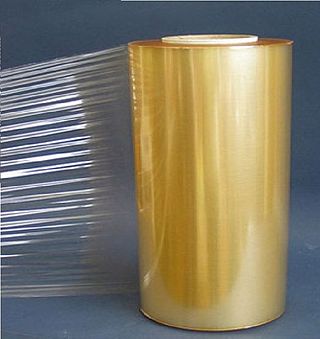
Plastic wrap, cling film, Saran wrap, cling wrap, Glad wrap or food wrap is a thin plastic film typically used for sealing food items in containers to keep them fresh over a longer period of time. Plastic wrap, typically sold on rolls in boxes with a cutting edge, clings to many smooth surfaces and can thus remain tight over the opening of a container without adhesive. Common plastic wrap is roughly 0.0005 inches thick. The trend has been to produce thinner plastic wrap, particularly for household use, so now the majority of brands on shelves around the world are 8, 9 or 10 μm thick.
Coated paper is paper that has been coated by a mixture of materials or a polymer to impart certain qualities to the paper, including weight, surface gloss, smoothness, or reduced ink absorbency. Various materials, including kaolinite, calcium carbonate, bentonite, and talc, can be used to coat paper for high-quality printing used in the packaging industry and in magazines.

Plastics extrusion is a high-volume manufacturing process in which raw plastic is melted and formed into a continuous profile. Extrusion produces items such as pipe/tubing, weatherstripping, fencing, deck railings, window frames, plastic films and sheeting, thermoplastic coatings, and wire insulation.
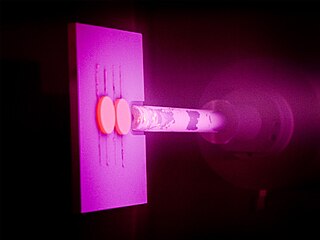
Physical vapor deposition (PVD), sometimes called physical vapor transport (PVT), describes a variety of vacuum deposition methods which can be used to produce thin films and coatings on substrates including metals, ceramics, glass, and polymers. PVD is characterized by a process in which the material transitions from a condensed phase to a vapor phase and then back to a thin film condensed phase. The most common PVD processes are sputtering and evaporation. PVD is used in the manufacturing of items which require thin films for optical, mechanical, electrical, acoustic or chemical functions. Examples include semiconductor devices such as thin-film solar cells, microelectromechanical devices such as thin film bulk acoustic resonator, aluminized PET film for food packaging and balloons, and titanium nitride coated cutting tools for metalworking. Besides PVD tools for fabrication, special smaller tools used mainly for scientific purposes have been developed.
A converter is a company that specializes in modifying or combining raw materials such as polyesters, adhesives, silicone, adhesive tapes, foams, plastics, felts, rubbers, liners and metals, as well as other materials, to create new products.

Food packaging is a packaging system specifically designed for food and represents one of the most important aspects among the processes involved in the food industry, as it provides protection from chemical, biological and physical alterations. The main goal of food packaging is to provide a practical means of protecting and delivering food goods at a reasonable cost while meeting the needs and expectations of both consumers and industries. Additionally, current trends like sustainability, environmental impact reduction, and shelf-life extension have gradually become among the most important aspects in designing a packaging system.
Applied Physics A: Materials Science and Processing is a peer-reviewed scientific journal that is published monthly by Springer Science+Business Media. The editor-in-chief is Thomas Lippert. This publication is complemented by Applied Physics B .
Anti-scratch coating is a type of protective coating or film applied to an object's surface for mitigation against scratches. Scratches are small surface-level cuts left on a surface following interaction with a sharper object. Anti-scratch coatings provide scratch resistances by containing tiny microscopic materials with scratch-resistant properties. Scratch resistance materials come in the form of additives, filters, and binders. Besides materials, scratch resistances is impacted by coating formation techniques. Scratch resistance is measured using the Scratch-hardness test. Commercially, anti-scratch coatings are used in the automotive, optical, photographic, and electronics industries, where resale and/or functionality is impaired by scratches. Anti-scratch coatings are of growing importance as traditional scratch resistance materials like metals and glass are replaced with low-scratch resistant plastics.
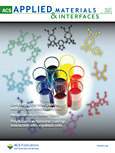
ACS Applied Materials & Interfaces is a peer-reviewed scientific journal that was established in 2009 by the American Chemical Society. Originally published monthly, the journal became biweekly in 2013 and weekly in 2015. The current editor-in-chief is Kirk S. Schanze. The journal covers research on advanced active and passive electronic/optical materials, coatings, colloids, biomaterials and bio-interfaces, polymers, hybrid and composite materials; and friction and wear.

The Journal of Coatings Technology and Research is a bimonthly peer-reviewed scientific journal. It is owned by the American Coatings Association and published on their behalf by Springer Science+Business Media. The editor-in-chief of the journal is Dr. Mark Nichols.
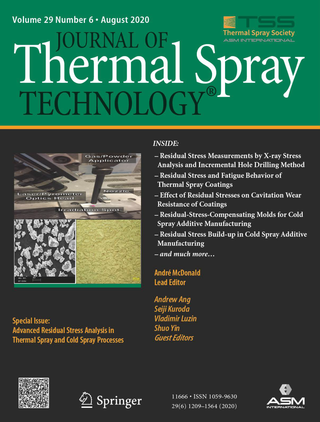
The Journal of Thermal Spray Technology is a peer-reviewed scientific journal that is dedicated to thermal science and its application for the improvement of material properties and functionality of coatings. The journal regularly publishes review papers and special issues. it is published by Springer Science+Business Media on behalf of ASM International. The editor-in-chief is Armelle Vardelle.

Plastic film is a thin continuous polymeric material. Thicker plastic material is often called a "sheet". These thin plastic membranes are used to separate areas or volumes, to hold items, to act as barriers, or as printable surfaces.
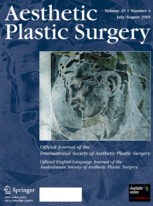
Aesthetic Plastic Surgery is a bimonthly peer-reviewed medical journal covering all aspects of aesthetic plastic surgery. It was established in 1976 and is published by Springer Science+Business Media on behalf of the International Society of Aesthetic Plastic Surgery. It is the official journal of the European Association of Societies of Aesthetic Plastic Surgery and the Sociedade Brasileira de Cirurgia Plastica. The editor-in-chief is Bahman Guyuron
The Materials Science Citation Index is a citation index, established in 1992, by Thomson ISI. Its overall focus is cited reference searching of the notable and significant journal literature in materials science. The database makes accessible the various properties, behaviors, and materials in the materials science discipline. This then encompasses applied physics, ceramics, composite materials, metals and metallurgy, polymer engineering, semiconductors, thin films, biomaterials, dental technology, as well as optics. The database indexes relevant materials science information from over 6,000 scientific journals that are part of the ISI database which is multidisciplinary. Author abstracts are searchable, which links articles sharing one or more bibliographic references. The database also allows a researcher to use an appropriate article as a base to search forward in time to discover more recently published articles that cite it.
Plastic Surgery is a peer-reviewed medical journal dealing with plastic surgery. It is the official journal of several national Canadian societies: the Canadian Society of Plastic Surgeons, the Canadian Society for Aesthetic (Cosmetic) Plastic Surgery, the Groupe pour l'Avancement de la Microchirurgie Canada, and the Canadian Society for Surgery of the Hand. The journal covers both research and material dealing with continuing medical education and society guidelines. It was published by the Pulsus Group, which was placed on Jeffrey Beall's list of "Potential, possible, or probable" predatory open-access publishers following its sale to OMICS Publishing Group. The journal subsequently switched publishers and is now published by SAGE Publications.
Materials Chemistry and Physics is a peer-reviewed scientific journal published 18 times per year by Elsevier. The focus of the journal is interrelationships among structure, properties, processing and performance of materials. It covers conventional and advanced materials. Publishing formats are short communications, full-length papers and feature articles. The editor-in-chief is Jenq-Gong Duh.
The Journal of Biomedical Materials Research is a peer-reviewed scientific journals of biomedical material science. It was established in 1967. In 1974, it absorbed Biomedical Materials Symposium (1971–1974). In 1990, it absorbed the journal Journal of Applied Biomaterials (1990–1995). In 2002, it split into two parts, Journal of Biomedical Materials Research Part A, and Journal of Biomedical Materials Research Part B. The two parts are published by John Wiley & Sons.
Annals of Plastic Surgery is a monthly peer-reviewed medical journal covering all aspects of plastic and reconstructive surgery. It is published by Lippincott Williams & Wilkins and the editor-in-chief is William C. Lineaweaver.










